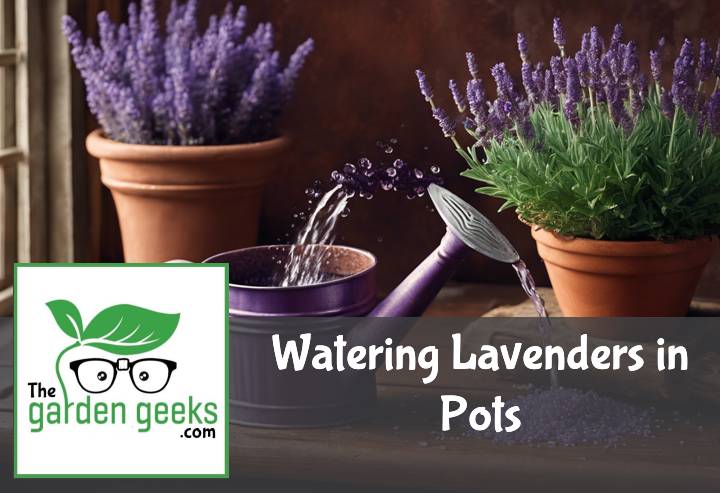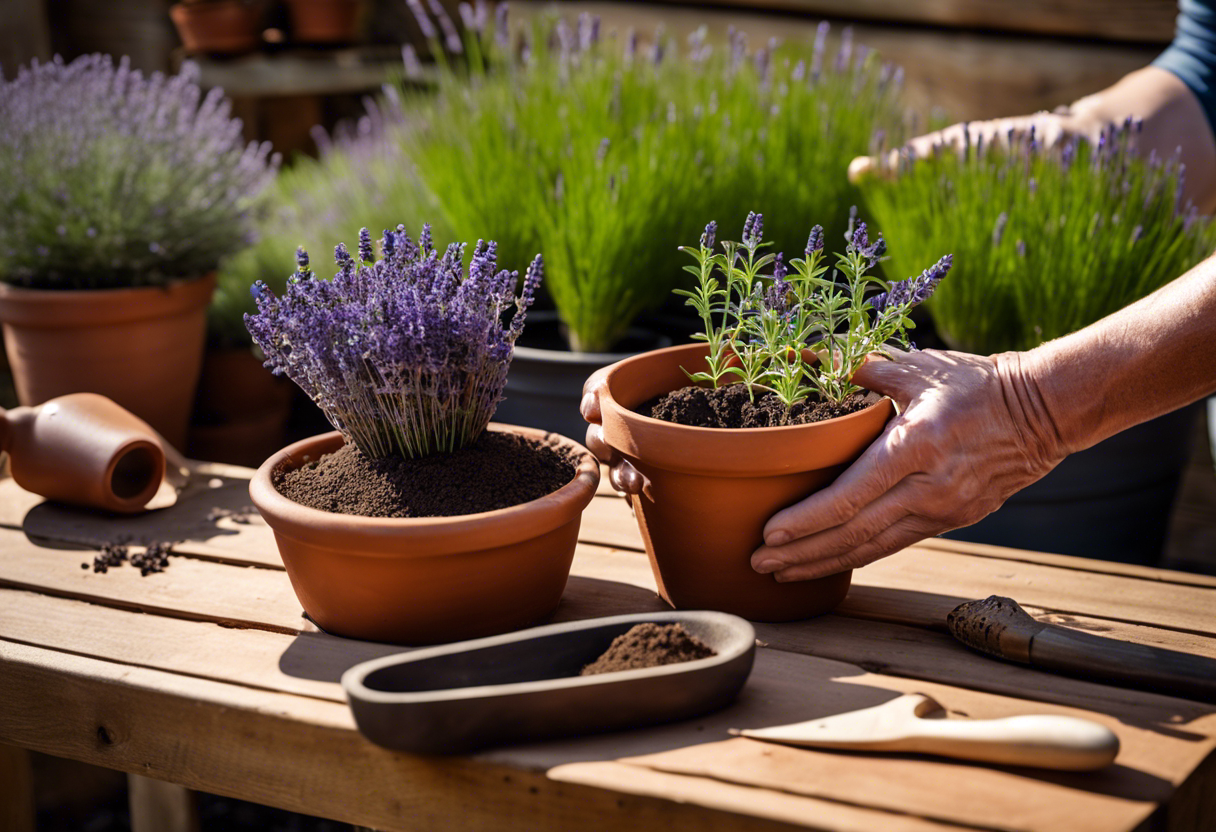Hey there, green thumb! Have you ever found yourself pondering the mysteries of Watering Lavenders in Pots? It’s a bit like figuring out how much coffee you need in the morning – too little and things just don’t work, too much and well… disaster strikes.
In this blog post, we’ll dive into the nitty-gritty of hydrating these purple beauties. We promise to keep it light-hearted while still giving you all the juicy details. So stick around, because it’s about to get real splashy up in here. Keep reading about ‘Watering Lavenders in Pots (How Often and How Much Water)’.
Key Takeaways
- Lavenders in pots need watering about once or twice a week during growing season, less often in winter.
- Water thoroughly until it runs out of the drainage holes, but ensure pot has good drainage to avoid waterlogging.
- Overwatering can cause root rot; underwatering leads to wilting.
- Soil should be slightly moist, not saturated or completely dry.
- Adjust watering frequency based on weather conditions and soil moisture levels.
Understanding Lavender’s Watering Needs
When it comes to lavender care, getting the watering right is a game-changer. You see, watering lavenders isn’t just about keeping the soil wet. It’s about understanding the lavender plant needs and how its native habitat influences its hydration requirements.
The Importance of Proper Watering for Lavenders
Now, let’s get down to the nitty-gritty. Proper watering for lavenders is like giving them a lifeline. It directly impacts their health and growth. Overdo it, and you might drown your precious lavender in a sea of water. That’s what we call overwatering lavenders.
On the flip side, if you’re stingy with water, your lavender may end up parched and thirsty. This condition is known as underwatering lavenders. Both scenarios can lead to detrimental effects on your lavender plant health due to improper watering.
How Lavender’s Native Habitat Influences Its Watering Needs
So where does lavender originally hail from? Well, it’s native to the Mediterranean region – think hot summers and dry winters. These conditions have shaped the lavender water requirements over time.
If you’re growing potted lavenders, mimicking these natural conditions can be a bit tricky but not impossible! By adjusting your watering routine and considering factors like sunlight exposure and pot size, you can create an environment similar to lavender’s native habitat.
Remember folks, when it comes to watering lavenders in pots, adaptation is key! Just like us humans adapting to different environments, our green friends need some adjustment too!
Identifying the Right Pot for Lavender
Choosing the right pot is a critical step in watering lavenders in pots. It’s not just about aesthetics, folks! The size of your pot and its drainage capabilities can significantly impact your lavender’s health and growth.
The Role of Pot Size in Watering Frequency and Volume
When it comes to lavender pot selection, size matters. A larger pot means more soil, which can hold more water. This reduces the lavender watering frequency as the plant has access to more moisture over a longer period.
On the flip side, smaller pots have less soil and therefore retain less water. This means you might need to water your lavender more frequently. But remember, it’s all about balance! Overwatering can be just as harmful as underwatering.
Adjusting your water volume for lavender based on pot size is essential too. You don’t want to drown your plant in a small pot or leave it parched in a large one!
Importance of Drainage in Pots for Lavender
Now let’s talk about drainage, another key factor in lavender container gardening. Good drainage is crucial when growing lavenders in pots. Why? Because lavenders hate having wet feet!
Without proper drainage, water can accumulate at the bottom of the pot, leading to root rot – not exactly what we’re aiming for here! So make sure you choose a pot with sufficient drainage holes.
But wait, there’s more! Even if you have a well-draining pot, overwatering can still cause issues. That’s why understanding how much water your lavender needs and preventing overwatering are equally important.
In conclusion, choosing an appropriate pot for lavender isn’t rocket science but requires some thoughtfulness. Keep these factors in mind and you’ll be well on your way to mastering best pots for lavender selection and creating optimal lavender growing conditions.
How Often to Water Lavenders in Pots?
When it comes to watering lavenders in pots, there’s no one-size-fits-all schedule. It depends on several factors, and understanding these can help you provide optimal lavender plant care. Whether your lavender is indoor or outdoor also affects the watering frequency for potted lavenders.
Factors Influencing the Frequency of Watering
Firstly, the climate plays a significant role in determining your indoor lavender watering schedule or outdoor potted lavender watering routine. In hotter climates, you might need to water more frequently than in cooler ones.
Secondly, the pot size and type are crucial too. Larger pots retain moisture longer than smaller ones, so they require less frequent watering. Similarly, clay pots absorb some water, meaning they dry out faster than plastic or ceramic pots.
Lastly, the soil type can greatly impact your lavender’s hydration needs. Well-draining soils like sandy or loamy soils are ideal for lavenders as they prevent waterlogging but may require more frequent watering.
Signs That Your Lavender Needs Watering
Recognizing when your lavender needs water is key to maintaining its health. One sign of a thirsty lavender is wilting leaves – a clear indication of dehydration. If you notice this, it’s time to give your plant a good soak.
On the other hand, over-watered lavenders show different symptoms such as yellow leaves or root rot. If you see these signs, hold off on watering until the soil dries out completely.
Remember folks! The trick to successful watering lavenders in pots is balance; not too much and not too little!
How Much Water Does a Potted Lavender Need?
When it comes to watering lavenders in pots, there’s no one-size-fits-all answer. Factors like pot size, soil type, and climate play a big role in determining the water needs of your lavender plant. It’s crucial to understand the signs of overwatering and underwatering as part of your potted lavender care routine.
Determining the Right Amount of Water
So, how do you figure out the right amount of water for your potted lavender? Well, it’s all about observation. A well-hydrated lavender will have vibrant foliage and strong stems. If you notice wilting or yellowing leaves, it might be time to adjust your watering indoor lavenders routine.
Remember that lavender water needs can change with the seasons too. They need more water during hot summer months and less during cooler periods. Adjust accordingly to ensure optimal outdoor lavender hydration.
Overwatering vs Underwatering: Risks and Symptoms
Overwatered and underwatered lavenders show different symptoms. An overwatered lavender may have yellow leaves and a soggy base – classic signs of root rot caused by too much moisture. To avoid this common watering mistake with lavenders, make sure your pot has good drainage.
On the other hand, an underwatered lavender will have dry, brittle leaves and weak stems. This is often due to insufficient watering or a pot that drains too quickly. Prevent this by ensuring your lavender gets enough water, but not so much that it drowns!
In conclusion, understanding the balance between overwatering and underwatering is key when caring for both indoor and outdoor potted lavenders.
Seasonal Adjustments to Watering Schedule
When it comes to watering lavenders in pots, it’s not a one-size-fits-all deal. You’ve got to adjust your watering schedule according to the seasons. Yes, you heard that right! Your potted lavender care needs to change with the weather.
Summer Watering Guidelines for Potted Lavenders
During those scorching summer months, your potted lavenders are going to be thirstier than a camel in the desert. So, ramp up your summer lavender watering routine. But don’t go crazy with the hosepipe! Remember, lavenders love well-drained soil and hate waterlogged roots.
The trick is keeping them hydrated without drowning them. Think of it as their very own Goldilocks situation – not too much, not too little, but just right. That’s your mantra for watering lavenders in summer.
Winter Care: Reducing the Frequency and Quantity of Water
Now when winter rolls around, it’s time to dial back on the H2O. Why? Because during these colder months, your potted lavenders are more dormant and need less water. Overwatering can lead to root rot and other nasty issues.
So how do you manage this? Well, reduce both frequency and quantity of water for your potted lavenders during winter. It’s all about balance folks! Keep an eye on the weather forecast and adjust accordingly – remember, they prefer being slightly dry over being drenched!
This is what we call smart winter lavender care – adjusting your watering schedule based on seasonal changes is key for healthy, happy lavenders all year round!
To Wrap Up
In the grand scheme of gardening, Watering Lavenders in Pots is like making sure a goldfish doesn’t overeat. It needs just enough, not too much!
So, keep your lavender happy with the right amount of hydration. Remember, it’s better to under-water than to drown these purple beauties. Happy watering!





